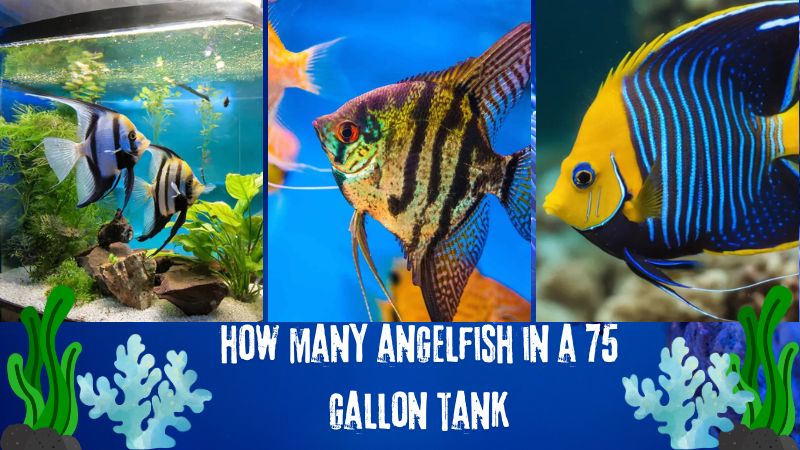Angelfish are stunning freshwater fish known for their vibrant colors and elegant fins. A 75-gallon tank offers a good amount of space for them, but it’s important not to overcrowd. So how many angelfish in a 75 gallon tank? This article Tropical Fish Haven will explore how many angelfish can comfortably grow in a 75 gallon tank, considering factors such as tank size, angelfish maturity, and potential tank mates.
First and Foremost, How Large Do Angelfish Grow?
The initial factor to consider when assessing the stocking density of a fish species is its eventual size.
Freshwater angelfish commonly originate from two main species of medium to large cichlids. The more common angelfish (Pterophyllum scalare) typically reaches a body length of up to 6 inches, while the Altum angelfish (Pterophyllum altum) can grow up to 7 inches in length.
However, adult angelfish are notably unique because their bodies are taller than they are long—Altum angelfish, for instance, may only reach 7 inches in length but can grow to be as tall as 12 inches!
In our calculations, we will utilize this maximum dimension of 12 inches to determine the maximum stocking density.
What Are the Dimensions of a 75-Gallon Aquarium?
The dimensions of a 75-gallon aquarium can vary, but a standard size is typically around 48.38 inches in length, 18.38 inches in width, and 21 inches in height.
Given that Angelfish require a tall aquarium due to their height of up to 12 inches, an aquarium significantly shorter than 21 inches in height would not be suitable as a permanent habitat for them.
Determining the Number of Angelfish for a 75-Gallon Aquarium
To calculate how many Angelfish can be comfortably housed in a 75-gallon tank, a specific formula is necessary.
While a general guideline for smaller fish suggests allocating one gallon per inch of fish, this rule isn’t suitable for medium to large fish species.
Imagine attempting to confine an 8-inch Oscar in an 8-gallon tank or a 10-inch Clown Loach in a 10-gallon aquarium—clearly impractical and not recommended at all!
Since adult Angelfish are considered medium to large fish, we will instead use Dick Mills’s Golden Rule, which recommends allocating 12 square inches of aquarium floor surface area per inch of fish.
How many angelfish in a 75 gallon tank?
To calculate the number of Angelfish that can comfortably inhabit a 75-gallon tank, we’ll use the recommended stocking guideline based on the floor area of the tank:
Calculate the Floor Area
- The dimensions of a standard 75-gallon tank are approximately 48 inches in length by 18 inches in width.
- Floor area = Length x Width
- Floor area = 48 inches x 18 inches
- Floor area = 864 square inches
Apply the Stocking Guideline
- According to the guideline of 12 square inches of tank floor area per inch of fish (Dick Mills’s Golden Rule),
- Maximum inches of fish = Floor area / 12
- Maximum inches of fish = 864 square inches / 12
- Maximum inches of fish = 72 inches
Calculate the Number of Angelfish
- Assuming adult Angelfish can reach a maximum height of 12 inches,
- Number of Angelfish = Maximum inches of fish / Height of Angelfish
- Number of Angelfish = 72 inches / 12 inches
- Number of Angelfish = 6
Therefore, a 75-gallon tank can comfortably accommodate approximately 6 adult Angelfish, given the dimensions and recommended stocking guideline. It’s important to consider factors like tank decorations, filtration capacity, and individual fish behavior when stocking your aquarium to ensure a healthy and thriving environment for your fish.
Why Six Angelfish Make an Excellent Choice
The number 6 proves to be ideal for Angelfish in several ways. Here’s why:
Angelfish Prefer Swimming in Schools
In their natural habitat, Angelfish are shoaling species that enjoy swimming together in groups. While they can be kept individually, they tend to thrive best in social settings where they can interact with each other.
Group Living Facilitates Pair Formation
Keeping Angelfish in groups increases the likelihood of them forming pairs. As they mature, Angelfish naturally seek out mates for breeding. Witnessing their courtship and breeding behaviors, characteristic of cichlids, can be a fascinating experience for aquarium enthusiasts.
Pairing Dynamics
Angelfish have a tendency to pair off as they mature. Maintaining an even number of Angelfish enhances the chances that all individuals in the tank will find compatible partners. This, of course, assumes an equal distribution of males and females among the fish.
In summary, maintaining a group of 6 Angelfish not only aligns with their natural social behavior but also enhances the potential for breeding and observing captivating courtship rituals in your aquarium setup.
Sexing Your Angelfish
Determining the Sex of Angelfish before maturity can be challenging, often requiring a bit of luck to achieve an equal ratio of males to females.
As Angelfish mature, males develop a pronounced hump on their forehead, known as an enlarged crown, which is characteristic of male cichlids. Additionally, during the breeding season, male Angelfish exhibit a small and pointed “breeding tube” that becomes more prominent.
Females typically mature slightly smaller than males but develop a larger, round, and cylindrical breeding tube.
These distinguishing features—such as enlarged crowns in males and prominent breeding tubes in females—usually become visible between 6 to 12 months of age, making it necessary to wait until this period to accurately determine the sex ratio in your group of Angelfish.
Conclusion
While a 75-gallon tank can hold a small group of angelfish, the ideal number depends on several factors. Following the rule of thumb of allowing 50 gallons for the first angelfish and 20 gallons for each additional one is a good starting point. Remember, angelfish can become territorial, and tank décor providing hiding spots is crucial for peaceful cohabitation. Ultimately, observing your angelfish behavior and water quality will guide you in determining the perfect number for your specific setup.





